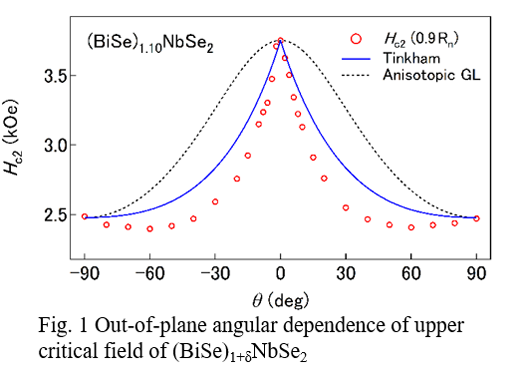PC3-5
Characterizations of Anisotropic Superconductivity in (BiSe)1+δNbSe2
*Soichiro Matsuzawa1, Sunseng Pyon1, Tsuyoshi Tamegai1
- Department of Applied Physics, The University of Tokyo1
Misfit layer compounds, denoted by (MX)1+δ(TX2)n (M = Sn, Pb, Sb, Bi, rare earth metals, T = Ti, V, Nb, Ta, Cr, X = S, Se ; 0.08 < δ < 0.28; n = 1, 2, 3), are built of alternately double layers MX with quasi NaCl-type structure and TX2 with slightly distorted trigonal prism. (BiSe)1+δNbSe2, belonging to misfit layer compounds, is reported to show superconductivity [1]. On the other hand, NbxBi2Se3, which is claimed to exhibit superconductivity by intercalating Nb atoms into the topological insulator Bi2Se3, has a transition temperature close to that of (BiSe)1+δNbSe2. Some researchers believe that the superconductivity in NbxBi2Se3 originates from (BiSe)1+δNbSe2 which exists as an impurity phase in NbxBi2Se3 crystal [2][3].
In this study, we synthesized single crystalline samples of (BiSe)1+δNbSe2 with different starting compositions following the method described in Ref [4]. M-T measurements showed the presence of two phases with transition temperatures 2.5 K and 3.1 K, suggesting that (BiSe)1+δNbSe2 can have different crystal structures on a microscopic scale. In particular, the transition temperature of the higher Tc phase is very close to that reported for NbxBi2Se3, suggesting that this phase could be the origin for superconductivity in NbxBi2Se3. In addition, we also measured the out-of-plane angular dependence of the upper critical field (Hc2(θ)). It was observed that Hc2 shows a cusp-like behavior at angles close to the ab-plane as shown in Fig. 1. This behavior is similar to the angular dependence of Tinkham model describing Hc2(θ) in a two-dimensional superconductor rather than the anisotropic GL model, though the anisotropy of Hc2 is small.
We will also discuss in-plane angular dependence of the upper critical field (Hc2(φ)) and its relevance to the reported nematicity in NbxBi2Se3.
[1] A. Nader et al., Solid State Commun. 101, 149 (1997).
[2] M. E. Kamminga et al., Commun. Mater. 1, 82 (2020).
[3] K. J. Dalgaard et al., Phys. Rev. B 103, 184103 (2021).
[4] M. Nagao et al., Solid State Commun. 321, 114051 (2020).
Keywords: misfit layer compounds
